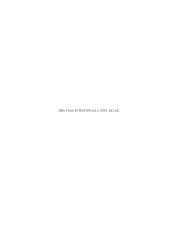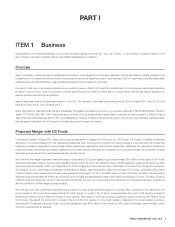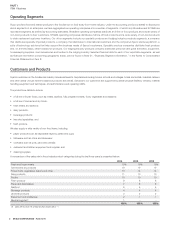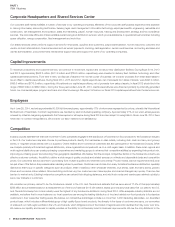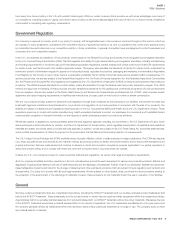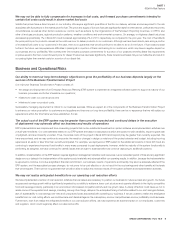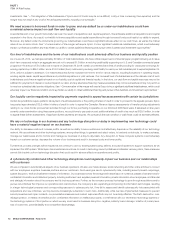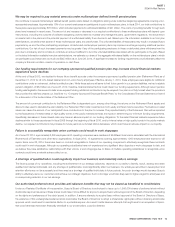Sysco 2014 Annual Report Download - page 20
Download and view the complete annual report
Please find page 20 of the 2014 Sysco annual report below. You can navigate through the pages in the report by either clicking on the pages listed below, or by using the keyword search tool below to find specific information within the annual report.
SYSCO CORPORATION-Form10-K8
PARTI
ITEM1ARisk Factors
The merger will dilute the ownership interests of Sysco’s existing stockholders
At the time of the consummation of the proposed merger, Sysco will issue approximately 87 million shares, or roughly 13% of Sysco’s outstanding common
stock after the transaction is completed. As a result, the ownership amounts of Sysco’s pre-merger stockholders will be diluted. Generally, dilution will
impact a stockholder’s ownership percentage and ability to in uence voting results, and will likely reduce earnings per share, which could impact stock price.
Industry and General Economic Risks
Periods of signi cant or prolonged in ation or de ation affect our product costs and may negatively impact our
pro tability
Volatile food costs have a direct impact on our industry. Periods of product cost in ation may have a negative impact on our pro t margins and earnings
to the extent that we are unable to pass on all or a portion of such product cost increases to our customers, which may have a negative impact on our
business and our pro tability. In addition, periods of rapidly increasing in ation may negatively impact our business due to the timing needed to pass on such
increases, the impact of such in ation on discretionary spending by consumers and our limited ability to increase prices in the current, highly competitive
environment. Conversely, our business may be adversely impacted by periods of product cost de ation, because we make a signi cant portion of our
sales at prices that are based on the cost of products we sell plus a percentage margin. As a result, our pro t levels may be negatively impacted during
periods of product cost de ation, even though our gross pro t percentage may remain relatively constant.
Our results of operations and nancial condition may be directly, adversely affected by unfavorable conditions in the
US economy and local markets, as well as negative trends in consumer con dence
The foodservice distribution industry, which is characterized by relatively low pro t margins with limited demand growth expected in the near-term, is
especially susceptible to negative trends and economic uncertainty. The United States (U.S.) has experienced an uneven economic environment over the
past several years. Despite job growth experiencing a positive trend, it has yet to translate into a signi cant impact on overall unemployment. The housing
segment is struggling to maintain consistent, positive trends, and this segment historically has been a key driver of economic growth. These factors indicate
that consumer disposable income is increasing modestly. In addition, our results of operations are substantially affected by local operating and economic
conditions, which can vary substantially by market. The dif cult economic conditions can affect us in the following ways:
•Unfavorable conditions can depress sales and/or gross margins in a given market.
•
Food cost and fuel cost in ation experienced by the consumer can lead to reductions in the frequency of dining out and the amount spent by consumers
for food-away-from-home purchases, which could negatively impact our business by reducing demand for our products.
•Heightened uncertainty in the nancial markets negatively affects consumer con dence and discretionary spending, which can cause disruptions with
our customers and suppliers.
•
Liquidity issues and the inability of our customers, vendors and suppliers to consistently access credit markets to obtain cash to support operations
can cause temporary interruptions in our ability to conduct day-to-day transactions involving the payment to or collection of funds from our customers,
vendors and suppliers.
The uncertainty in the economic environment has adversely affected the rate of improvement in both business and consumer con dence and spending,
and uncertainty about the long-term investment environment could further depress capital investment and economic activity.
Competition in our industry may adversely impact our margins and our ability to retain customers, and makes it
dif cult for us to maintain our market share, growth rate and pro tability
The foodservice distribution industry is fragmented and highly competitive, with local, regional, multi-regional distributors and specialty competitors.
Furthermore, barriers to entry by new competitors, or geographic or product line expansion by existing competitors, are low. Additionally, increased
competition from non-traditional sources (such as club stores and commercial wholesale outlets with lower cost structures), and group purchasing
organizations have served to further increase pressure on the industry’s pro t margins, and continued margin pressure within the industry may have a
material adverse impact on our operating results and pro tability. Finally, demand for food-away-from-home products is volatile and price sensitive, imposing
limits on our customers’ ability to absorb cost increases. New and increased competitive sources may result in increased focus on pricing and on limiting
price increases, or may require increased discounting. Such competition or other industry pressures may result in margin erosion and/or make it dif cult
for us to attract and retain customers.
Although our sales historically have grown faster than the market, industry growth rates have slowed over the past several years, and industry sources
expect the lower growth rates to continue in the near-term. These trends have placed pressure on our pro t margins and made it more dif cult to
leverage our cost structure and pass along cost increases. We expect these trends to continue for the foreseeable future. If we are unable to effectively
differentiate ourselves from our competitors, our market share, sales and pro tability, through increased expenditures or decreased prices, could be
adversely impacted.


